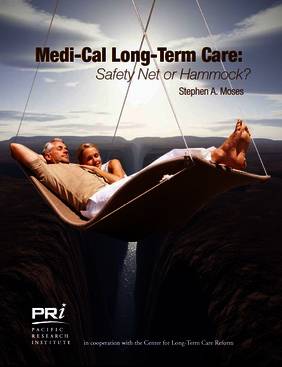San Francisco—The continuous expansion of Medi-Cal long-term care benefits could cause a financial catastrophe in California according to a new report by the Pacific Research Institute (PRI), a California-based think tank, in cooperation with the Center for Long-Term Care Reform. Medi-Cal Long-Term Care: Safety Net or Hammock?, by Stephen A. Moses, president of the Center for Long-Term Care Reform, finds that easy access to Medi-Cal-financed long-term care (LTC) has caused many Californians to put off long-term care planning and rely on public assistance. The taxpayer price tag for Medi-Cal Long-Term Care was $12.5 billion in 2008 and will likely increase with the growing population of age-80-plus citizens in the state.
“Conventional wisdom says that Medi-Cal long-term care eligibility requires poverty-level income and very low assets,” said Mr. Moses. “But the truth is that most middle-class and even affluent people qualify for the program as a result of easy and elastic eligibility rules. Consequently, Medi-Cal LTC provides a safety net for too few of California’s neediest citizens and a hammock for too many who could have afforded to plan for LTC.”
According to Medi-Cal Long-Term Care: Safety Net or Hammock? , Californians’ excessive dependency on Medi-Cal, with its inadequate and uncertain reimbursements, has created a burden at all levels, debilitating access to care for the truly needy and privately uninsurable. Financing Medi-Cal LTC is a large and growing strain on California’s budget. Yet federal law and regulations inhibit some effective corrective actions California could take. The report recommends that state officials:
- Clearly establish the principle that long-term care is a personal responsibility, not a social “right”.
- Conduct a comprehensive review of the current LTC service delivery and financing system to identify and eliminate policies that encourage public dependency.
- Incentivize the middle class and affluent to plan early and save, invest, or insure for LTC.
- Reduce the number of expensive Medi-Cal/Medicare “dual eligibles” in the future by diverting more Californians to private LTC financing alternatives while they are still young enough, healthy enough and affluent enough to save, invest or insure LTC.
“The basic problem is that Medi-Cal LTC does too much for too many too poorly,” concluded Mr. Moses. “By applying these principles, long-term care services can do a better job of providing care for genuinely needy people who depend on a radically smaller and much less expensive social LTC safety net.”
You can watch a short video explaining the eligibility loopholes in the Medi-Cal LTC program on PRI’s Youtube page.


